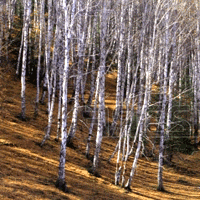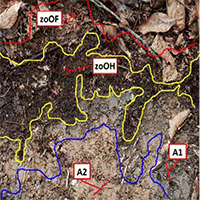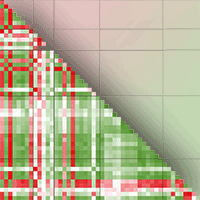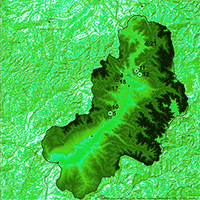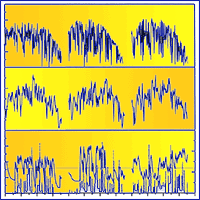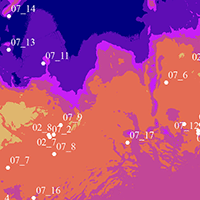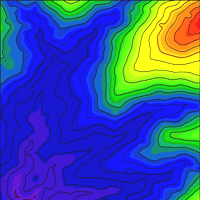
Soil water deficit as a tool to measure water stress and inform silvicultural management in the Cape Forest Regions, South Africa
Gerhardus Petrus Scheepers, Ben Du Toit
iForest - Biogeosciences and Forestry, Volume 13, Issue 6, Pages 473-481 (2020)
doi: https://doi.org/10.3832/ifor3059-013
Published: Nov 01, 2020 - Copyright © 2020 SISEF
Research Articles
Abstract
An understanding of variations in water availability to plantation forests on a spatial and temporal scale is essential when designing risk averse and site-specific silvicultural management regimes. Various indices of site water availability were compared to each other and to an independent, unbiased estimate of stand productivity potential, namely site index, across the Tsitsikamma, Knysna and Boland forestry regions of South Africa. This was done to find the balance between water availability indices requiring intensive data inputs (that may be very accurate) and indices with lower input data requirements (but may sacrifice some accuracy). The following indices of water availability (in order from low to higher input data requirements) were tested: Mean Annual Precipitation (MAP); Aridity Index (AI), i.e., MAP as a fraction of mean annual potential evapotranspiration (Ep); Moisture Growing Season (MGS), i.e., the Julian days where long-term MAP exceeds 0.3 times Ep; Water Deficit (WD), an estimate based on a rudimentary water balance with relatively low data inputs. The first three estimates use only climatic variables while the WD incorporates soil water storage capacity to run a water balance calculation. Results showed that both regional climatic variability and soil properties significantly affected the level of water availability, and hence also the potential productivity of pine stands. The shallow and sandy soils from the Knysna and Boland regions exhibited rapid water depletion during periods of decreased precipitation and seasonal shifts, however, the large WD’s (up to 345 mm year-1) observed in several of these sites rapidly changed to surplus values following only one month of high precipitation. Sites from the Tsitsikamma region had significantly larger water retention capabilities and this was attributed to the regional soil properties and climatic conditions. Temporal variations in the WD were also quantified. The WD estimates correlated significantly (r = -0.80, p<0.001) to the respective site indices from sites across all regions. These results underscore the importance of soil water availability on plantation productivity, especially in moderately dry regions or in areas with either shallow soils or a seasonal rainfall pattern. We conclude that the WD is a fairly accurate estimate of site-specific water availability with relatively low data requirements. The WD estimates are far superior to currently used indices of water availability in Southern Africa and has data input requirements that are currently readily available for most plantation forest sites.
Keywords
Soil Water Availability, Climatic Gradient, Slash Pine, Monterey Pine, Edaphic Properties
Authors’ Info
Authors’ address
Ben Du Toit
Department of Forest and Wood Science, Stellenbosch University, Private Bag X1, Matieland 7602 (South Africa)
Corresponding author
Paper Info
Citation
Scheepers GP, Du Toit B (2020). Soil water deficit as a tool to measure water stress and inform silvicultural management in the Cape Forest Regions, South Africa. iForest 13: 473-481. - doi: 10.3832/ifor3059-013
Academic Editor
Giustino Tonon
Paper history
Received: Feb 05, 2019
Accepted: Aug 17, 2020
First online: Nov 01, 2020
Publication Date: Dec 31, 2020
Publication Time: 2.53 months
Copyright Information
© SISEF - The Italian Society of Silviculture and Forest Ecology 2020
Open Access
This article is distributed under the terms of the Creative Commons Attribution-Non Commercial 4.0 International (https://creativecommons.org/licenses/by-nc/4.0/), which permits unrestricted use, distribution, and reproduction in any medium, provided you give appropriate credit to the original author(s) and the source, provide a link to the Creative Commons license, and indicate if changes were made.
Web Metrics
Breakdown by View Type
Article Usage
Total Article Views: 39484
(from publication date up to now)
Breakdown by View Type
HTML Page Views: 33567
Abstract Page Views: 2829
PDF Downloads: 2424
Citation/Reference Downloads: 3
XML Downloads: 661
Web Metrics
Days since publication: 1870
Overall contacts: 39484
Avg. contacts per week: 147.80
Citation Metrics
Article Citations
Article citations are based on data periodically collected from the Clarivate Web of Science web site
(last update: Mar 2025)
Total number of cites (since 2020): 3
Average cites per year: 0.50
Publication Metrics
by Dimensions ©
Articles citing this article
List of the papers citing this article based on CrossRef Cited-by.
References
Surface resistance calibration for a hydrological model using actual evapotranspiration retrieved from remote sensing data in Nahe catchment forest area. In: Proceedings of the “EGU General Assembly 2014”. Vienna (Austria) 27 Apr - 2 May 2014. Geophysical Research Abstracts, vol. 16, EGU2014-11915.
Online | Gscholar
Particle density. In: “Encyclopedia of Soil Science” (Chesworth W ed). Springer, Netherlands, pp. 504-505.
Gscholar
The nature and properties of soils (14th edn). Prentice Hall, New York, USA, pp. 975.
Gscholar
Information requirements to fertilize plantations with greater precision in a dry country. In: Proceedings of the International Precision Forestry Symposium “Precision Forestry in Plantations, Semi-natural and Natural Forests” (Ackerman PA, Längen DW, Antonides MC eds). Stellenbosch University (South Africa) 5-10 Mar 2006, pp. 245-260.
Gscholar
Matching site, species and silvicultural regime to optimise the productivity of commercial softwood species in southern Africa. In: “South African Forestry Handbook (5th edn)” (Bredenkamp BV, Upfold S eds). Southern African Institute of Forestry, Pretoria, South Africa, pp. 43-49.
Gscholar
Elements of silvicultural systems and regimes used in southern African plantations. In: “South African Forestry Handbook (5th edn)” (Bredenkamp BV, Upfold S eds). Southern African Institute of Forestry, Pretoria, South Africa, pp. 21-25.
Gscholar
Ground-based investigation of soil moisture variability within remote sensing footprints during the Southern Great Plains (1997) hydrology experiment. Water Resources Research 35: 1839-1851.
CrossRef | Gscholar
Analysis and modelling of water supply and demand under climate change, land use transformation and socio-economic development: the water resource challenge and adaptation measures for Urumqi region, Northwest China. Springer Science and Business Media, Cham, Switzerland, pp. 243.
Online | Gscholar
Moisture availability, crop period and the prospects for early warning of famine in Ethiopia. International Livestock Centre for Africa Bulletin 21: 2-9.
Gscholar
Site requirements of commercial Eucalyptus and Corymbia species in Southern Africa. In: “South African Forestry Handbook (5th edn)” (Bredenkamp BV, Upfold S eds). Southern African Institute of Forestry, Pretoria, South Africa, pp. 51-58.
Gscholar
Silviculture of industrial pine plantations in Southern Africa. In: “South African Forestry Handbook (5th edn)” (Bredenkamp BV, Upfold S eds). Southern African Institute of Forestry, Pretoria, South Africa, pp. 123-139.
Gscholar
Forest management: growth modelling and yield tables. In: “South African Forestry Handbook (5th edn)” (Bredenkamp BV, Upfold S eds). Southern African Institute of Forestry, Pretoria, South Africa, pp. 185-190.
Gscholar
Estimating available water capacity from basic soil physical properties - A comparison of common pedotransfer functions. Braunschweig Technical University, Brunswick, Germany, pp. 37.
Gscholar
Meteorologia agricola [Agricultural meteorology]. Course booklet, ESALQ, University of Sao Paulo, Escola Superior de Agricultura “Luiz de Queiroz”, Departamento de Ciências Exatas, Piracicaba, Brazil, pp. 192. [in Portuguese]
Gscholar
South African atlas for agrohydrology and climatology. Report TT82/96, Water Research Commission, Pretoria, South Africa, pp. 279.
Gscholar
Soils of the coastal zone. In: “Encyclopedia of Soil Science” (Chesworth W eds). Springer, Netherlands, pp. 711-733.
Gscholar
A strategic forestry site classification for the summer rainfall region of southern Africa based on climate, geology and soils. ICFR bulletin series no. 03/2005, Institute for Commercial Forestry Research, Pietermaritzburg, South Africa, pp. 33.
Gscholar
Soil classification - A taxonomic system for South Africa. Department of Agricultural Development, Pretoria, South Africa, pp. 257.
Gscholar
On evapotranspiration. In: “Report of the Committee on Transpiration and Evaporation, 1943-1944” (Wilm HG ed). Transactions of the American Geophysical Union 25: 686-693.
Gscholar
The water balance. Centerton, New Jersey, Laboratory of Climatology, Publications in Climatology 8 (1): 1-104.
Gscholar

